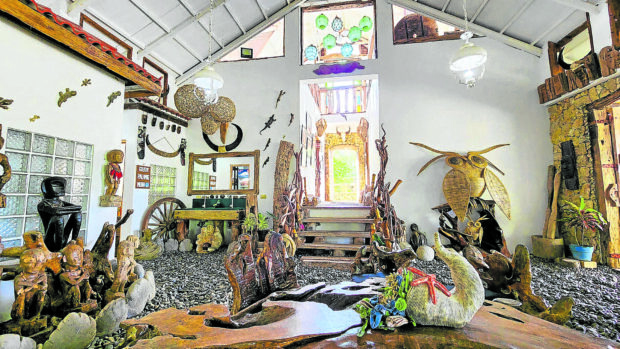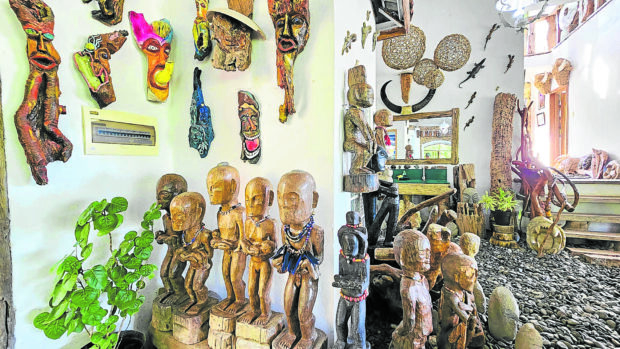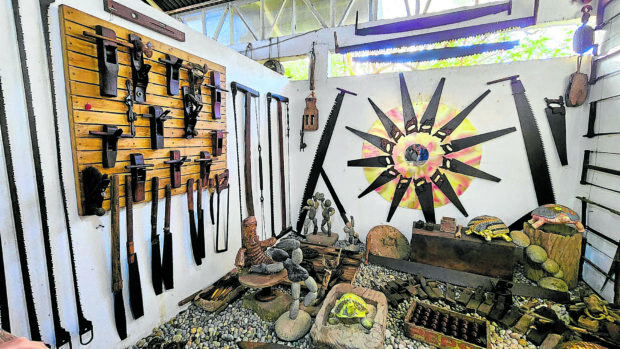On La Union’s pebble beach rises an art haven

SEASIDE TREASURES Entering Bahay na Bato (stone house) in Luna town, La Union, is like strolling on the pebble beach as its floors consist of stacked stones. —PHOTOS BY WILLIE LOMIBAO
LUNA, LA UNION—“Luna” may evoke visions of romantic moonlit nights but this town, whose name is also the Spanish term for moon, is gaining popularity for its unique houses and artworks created out of seemingly commonplace rocks, stones and pebbles.
After all, the town has a 3-kilometer stretch of pebble beach, which itself is a tourism attraction aside from being a source of livelihood for residents who gather and sell different shapes and colors of pebbles used in gardens and for landscaping.
There are at least three tourism landmarks that have capitalized on stones and pebbles to lure tourists to the town—Bahay na Bato, Bato de Luna Art Gallery and Kamay na Bato, all at Barangay Nalvo Norte.
“Stone is the most abundant resource in the town, so we used it to create something attractive and maybe intriguing,” Beverly Kim, owner of Kamay na Bato and Bato de Luna Art Gallery, said in a recent interview.
Bato de Luna is an expansion of Kamay na Bato owned by Kim Yoon (a Korean who is a naturalized Filipino citizen) and his wife Beverly.
Article continues after this advertisementREAD: Iloko-Bago cultures highlighted in La Union festival
Article continues after this advertisementA turtle-shaped building with its head jutting out of the massive shell and looking towards the sky is the main attraction of Bato de Luna. The building houses 3D paintings of human faces in different expressions.
“The idea is that we may go through different problems and emotions, but at the end of the day, we should be smiling,” Kim said.

It houses artworks and sculptures of local artists and stone decorations for both the house and its grounds.
Sea turtle haven
Mr. Kim drew inspiration from the enduring lifespan of turtles when he designed the Turtle House, hoping the structure could also endure time.
Kim carves rocks and stones turning these into works of art, mostly images of creatures of the sea like turtles. These are displayed at the gallery and on its grounds, where a pair of giant boots makes for a unique backdrop for selfies.
Yoon thought of turtles as the half-hectare gallery’s theme because Luna, like its neighboring towns of San Juan and Balaoan, are known as nesting sites of sea turtles.
The Kims established Bahay ni Luna in 2019 after Bahay na Bato, which Beverly used to manage, closed its doors to tourists that same year.
“Many tourists were coming but were disappointed when they could not enter Bahay na Bato, so my husband and I decided to establish our own gallery with similar features,” Kim said.
Bahay na Bato, a 3-ha property that overlooks the pebble beach and the sea and has man-made pockets of forests, reopened in 2021 to tourists. Its main attraction is a bahay na bato, literally a stone house.
It looks like the stones and other materials sourced from the coastline acquired a life of their own and formed a house. Stepping indoors would be no different from walking on the pebble beach because the floors are stacks of stones.
Wooden planks and beams from demolished old houses were used as stairs and decorative materials. The facade is decorated with coral-looking limestones, which are considered waste materials by a nearby cement plant.

GLIMPSE OFTHE PAST Sitting on a 3-hectare property overlooking the West Philippine Sea, the Bahay na Bato also features an art gallery that has become a repository of artifacts and
antique tools used by locals in farming, fishing and carpentry.
Relaxing view
Baguio City-based doctors Edison and Purita Chan Noble own Bahay na Bato. They built the house, supposedly as their secret hideaway, where they can enjoy the relaxing sea breeze and scenery, far from their everyday mountain view.
But the secret hideaway, built in 2000, was not to be a secret for long. In 2015, local officials urged the Nobles to open the house to visitors, and since then, hundreds of tourists come daily for the rare experience of exploring stone art and architecture.
Earlier, in 2008, Yoon, who is also a sculptor, proposed to the Nobles that he would redesign the house by constructing an attic and making stone decorations for both the house and its grounds.
The source of his art materials, actually boulders, is the Amburayan River, which also brings the pebbles and stones to the beach. Under the skillful hands and imaginative mind of Kim, the boulders that looked ordinary to some became works of art.
Soon, the yard was full of sculptures depicting creatures of the sea, disfigured faces and other unique pieces of art. Even the garden set was carved out of massive rocks, and the bonfire corner is surrounded by stones with different designs that serve as seats for campers.
Yoon has trained some residents on sculpting, and some of their works are on display.
Bahay na Bato maintains two galleries. One houses the interactive arts and display of artworks (mostly paintings) by local artists. The second gallery is a museum of artifacts, divided into rooms, with each room displaying old tools from occupations like farming, fishing, carpentry and others.
“Most of the young generation no longer know these tools used by their forefathers, and through the display, they would learn the kinds of tools used by the older generations,” Kim said.
Kim said her husband created all these because he wanted to show that stones have many uses.
“They are not only for walking on the beaches or used for construction. They can become works of art,” she said.